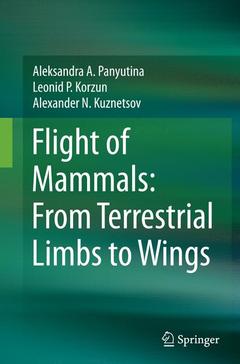Flight of Mammals: From Terrestrial Limbs to Wings, 2015
Auteurs : Panyutina Aleksandra A., Korzun Leonid P., Kuznetsov Alexander N.

Dr. Alexandra A. Panyutina serves in the Department of Vertebrate Zoology at Russia's Moscow State University. She has studied the evolution of bat flight since 2005. Prior to that, she studied the morpho ecological diversity of rhinolophid bats.
Dr. Leonid P. Korzun serves as Professor and Head of the Department of Vertebrate Zoology at Moscow State. He has studied the morphological evolution of vertebrates (mainly birds) by means of functional analysis since 1970.
Dr. Alexander N. Kuznetsov also serves in the Department of Vertebrate Zoology at Russia's Moscow State University. He has studied vertebrate locomotion since 1985, when he published the original model of the three-segment Z-like structure of mammalian parasagittal limb, which is now generally accepted by the scientific community.
Offers an explanation of the acquisition of flapping flight in mammals
Establishes a model of shoulder girdle mobility in flight that differs significantly from previous models
Suggests that flight in mammals resulted from a sequence of successive morphofunctional transformations rather than phylogenetic apomorphies
Includes supplementary material: sn.pub/extras
Date de parution : 10-2016
Ouvrage de 303 p.
15.5x23.5 cm
Date de parution : 04-2015
Ouvrage de 303 p.
15.5x23.5 cm



